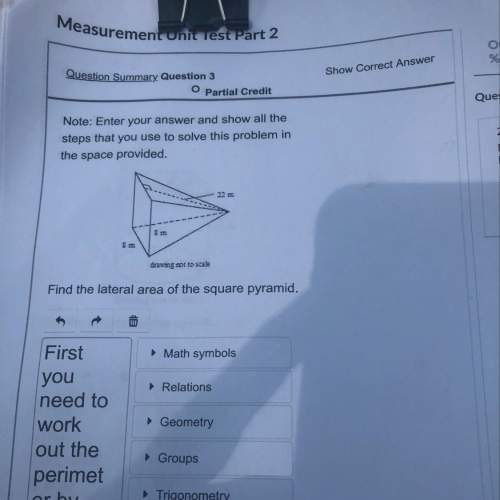
Mathematics, 10.03.2020 23:33 juelchasse
ILL MARK YOU BRAINLIEST A neighborhood is trying to set up school carpools, but they need to determine the number of students who need to travel to the elementary school (ages 5–10), the middle school (ages 11–13), and the high school (ages 14–18). A histogram summarizes their findings:
Histogram titled Carpool, with Number of Children on the y axis and Age Groups on the x axis. Bar 1 is 5 to 10 years old and has a value of 6. Bar 2 is 11 to 13 years old and has a value of 7. Bar 3 is 14 to 18 years old and has a value of 2.
Which of the following data sets is represented in the histogram?
{6, 6, 6, 6, 6, 6, 7, 7, 7, 7, 7, 7, 7, 2, 2}
{11, 11, 12, 5, 10, 7, 10, 8, 6, 11, 11, 12, 18, 14, 13}
{6, 5, 10, 12, 11, 7, 2, 14, 18}
{6, 14, 6, 8, 8, 19, 11, 12, 13, 10, 4}

Answers: 2


Another question on Mathematics

Mathematics, 21.06.2019 18:30
The base of a triangle is 8 1 3 meters and the height of the triangle is the fourth root of 16 meters meters. what is the area of the triangle?
Answers: 3

Mathematics, 21.06.2019 19:00
The diagonals of a quadrilaretral intersect at (-1,4). one of the sides of the quadrilateral is bounded by (2,7) and (-3,5) determine the coordinates of the other side in order for the quadrilaretral to be a square.
Answers: 1

Mathematics, 22.06.2019 00:30
What is the perimeter of a rectangle if the length is 5 and the width is x?
Answers: 3

Mathematics, 22.06.2019 07:50
Assume the population consists of the values 1, 3, 14. assume samples of 2 values are randomly selected with replacement (see page 23 for a definition) from this population. all the samples of n=2 with replacement are 1 and 1, 1 and 3, 1 and 14, 3 and 1, 3 and 3, 3 and 14, 14 and 1, 14 and 3, and 14 and 14. for part a) of this project, find the variance σ2 of the population {1, 3, 14}. for part b) of this project, list the 9 different possible samples of 2 values selected with replacement, then find sample variance s2 (which includes division by n-1) for each of them, and finally find the mean of the sample variances s2. for part c), for each of the 9 different samples of 2 values selected with replacement, find the variance by treating each sample as if it is a population (using the formula for population variance, which includes division by n), then find the mean of those population variances. for part d), which approach results in values that are better estimates of σ2 from part a): part b) or part c)? why? when computing variances of samples, should you use division by n or n-1? upload your answers for a), b), c), and d). the preceding parts show that s2 is an unbiased estimator of σ2. is s and unbiased estimator of σ? the above problem is from triola’s essentials of statistics, 4th edition.
Answers: 2
You know the right answer?
ILL MARK YOU BRAINLIEST A neighborhood is trying to set up school carpools, but they need to determi...
Questions

Mathematics, 23.11.2020 20:50


English, 23.11.2020 20:50

English, 23.11.2020 20:50


Mathematics, 23.11.2020 20:50

Chemistry, 23.11.2020 20:50


Mathematics, 23.11.2020 20:50

Mathematics, 23.11.2020 20:50

Mathematics, 23.11.2020 20:50


Computers and Technology, 23.11.2020 20:50




Mathematics, 23.11.2020 21:00









